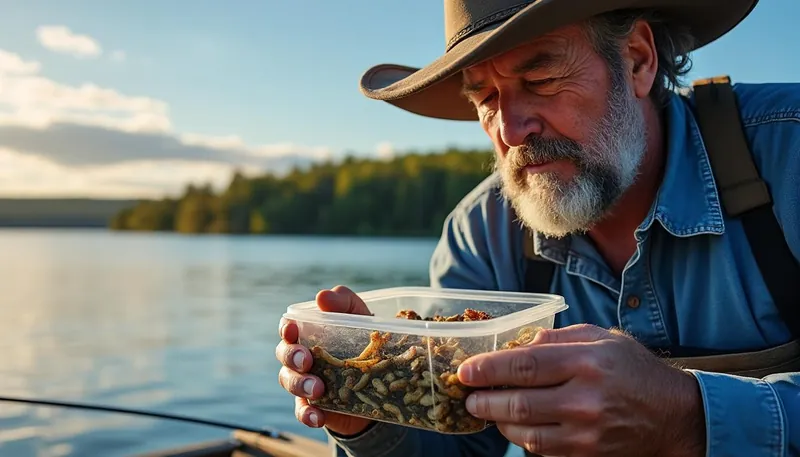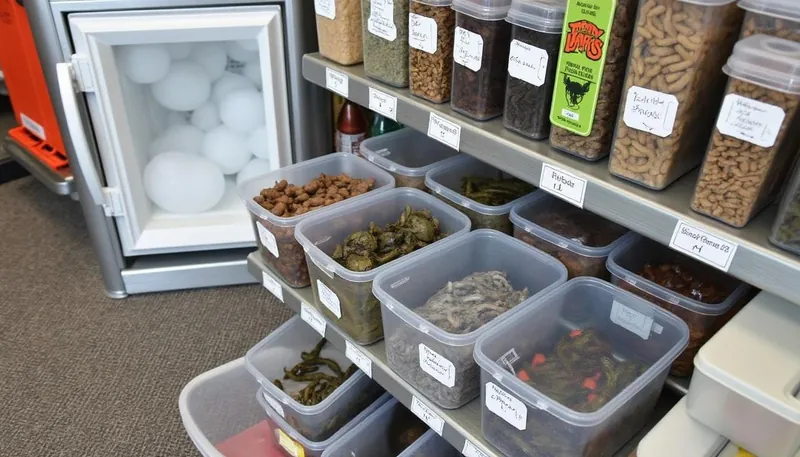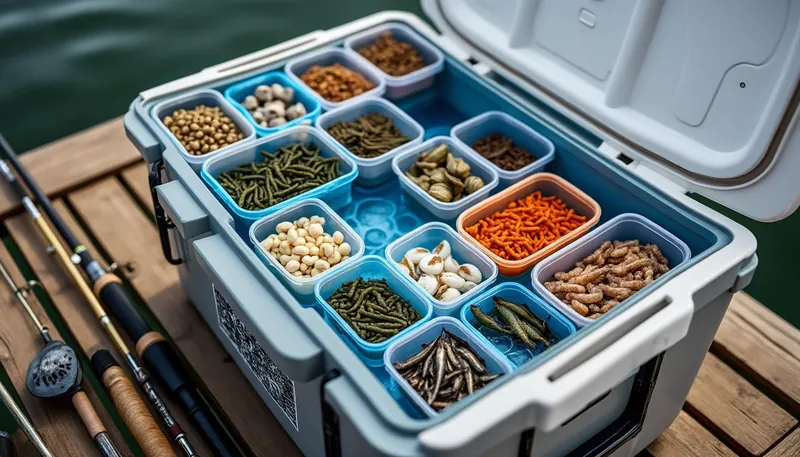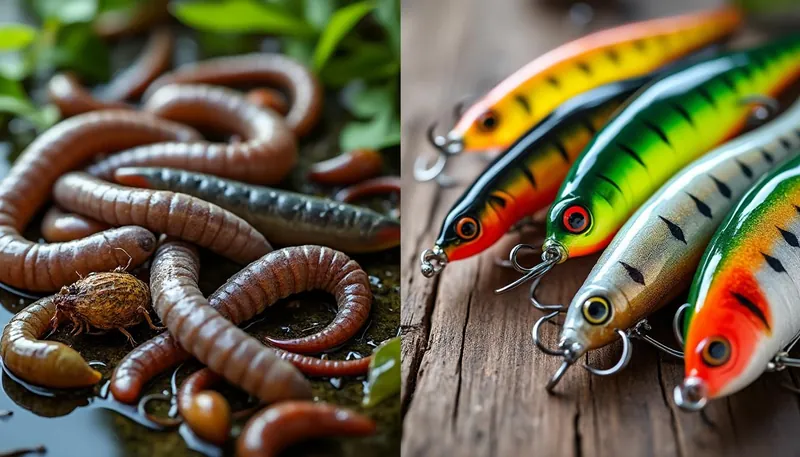Have you ever been out fishing, only to discover your live bait has turned into a mushy mess? It’s honestly a buzzkill when your precious bait goes bad before you’ve even dropped your line. The key to a successful day on the water often hinges on how well you can keep your bait fresh and lively. With just a few techniques and some nifty tips, you can ensure your live bait stays fit and active, ready to lure in that big catch. Whether you’re just starting or consider yourself a seasoned angler, learning to keep bait fresh is vital for maximizing your fishing success. In this article, we’ll explore various methods to ensure your bait remains lively and effective throughout your trip.
Brief
- Fresh bait is essential for successful fishing 🎣.
- Maintain optimal temperature and moisture levels for different bait types 🔄.
- Use proper storage techniques, including aerated buckets and effective bedding materials 🛠️.
- Be mindful of your bait’s natural behavior and habitat requirements 🙈.
- Implement tools like aerators and insulated containers to keep bait fresh long-term 🔧.
Understanding the Importance of Fresh Bait
Keeping live bait fresh isn’t just about basic care; it plays a crucial role in your fishing performance. Fresh bait brings a host of benefits, primarily because it attracts fish more effectively than stale or deteriorated options. Think of bait as the first impression – if it’s not appealing, the fish won’t take a bite. Research shows that fish are drawn to the natural odors and vibrant movements of lively bait, triggering their instinctive feeding responses.
Why does fresh bait make such a big difference? Here are a few points to consider:
- Natural Aroma: 🌊 Fresh bait releases a scent that entices fish. The more pungent and appealing the bait, the higher your chances of attracting nearby fish.
- Realistic Movement: 🎏 Active bait mimics the natural motions of prey, making it more convincing and exciting for fish.
- Enhanced Visibility: 👀 Fresh bait tends to look healthier, creating a visual appeal that attracts predators looking for an easy meal.
Moreover, keeping bait fresh can also help you catch a broader range of species. For example, using lively worms may entice various freshwater fish, while energetic minnows can target game fish like bass or pike. Differentiating among types of bait can help in improving your fishing success rate by strategically pairing bait with specific fish preferences.

The Types of Live Bait and Their Maintenance
Now that we established the benefits of fresh bait, let’s dive into the types commonly used in fishing and the ways to keep them lively. There’s a whole spectrum out there, and knowing the best practices for each can be a game changer.
| Type of Bait | Common Uses | Maintenance Tips |
|---|---|---|
| Worms 🌱 | Great for freshwater species like trout and panfish. | Keep in a cool, dark space with moist bedding; avoid overcrowding. |
| Minnows 🐟 | Popular for species like bass and walleye. | Use aerated containers; change water frequently and keep it cool. |
| Leeches 🐍 | Effective for catfish and bass. | Store in water or moisture; avoid direct sunlight. |
Understanding these types can help you prepare accordingly. For example, worms prefer cool environments and moisture-rich conditions. Conversely, minnows need an oxygen-rich aquatic environment to thrive. By adjusting your storage techniques based on the bait type, you can significantly extend their lifespan and effectiveness.
Effective Storage Techniques for Live Bait
Once you understand how to maintain your bait’s health, the next step is effective storage techniques. Whether you’re using buckets, coolers, or specialized containers, the right storage method can make all the difference in keeping your bait fresh…
- Aerated Buckets: 🚰 Utilize an aerated container specifically designed for live bait. This provides oxygen, helping keep minnows and other aquatic bait lively.
- Coolers: ❄️ A good-quality cooler such as those from names like YETI or Igloo maintains an even temperature, crucial for avoiding heat stress.
- Insulated Bags: 💼 Many anglers swear by bags from brands like Coleman or Plano for short trips, ensuring proper temperature regulation.
Moreover, when we think about bedding for worms, consider materials like peat moss or moist newspaper – just be sure to keep them fresh by replacing them regularly. Proper maintenance often means the difference between bait that lasts a couple of hours versus a full day on the water.

Organizing Your Bait Storage
Keeping your bait organized is just as crucial as proper storage. Using different compartments for different types of bait can help you avoid contamination and keep track of what’s fresh and what needs to be used. Consider models from brands like KastKing or Frabill that have separate compartments for optimal organization.
| Container Type | Key Features | Ideal For |
|---|---|---|
| Bait Tubs 🧊 | Insulated, air holes for ventilation. | Worms and leeches. |
| Aeration Systems 🔋 | Battery-operated for constant oxygen supply. | Minors and baitfish. |
| Multi-Sectional Boxes 🧰 | Removable dividers and customizable configurations. | All bait types. |
Preservation Tools You Should Consider
In the current year, 2025, technology has advanced in numerous ways, enhancing how we keep our bait fresh. There are several preservation tools you can invest in:
- Live Bait Aerators: 💨 Devices like the Energizer Portable Bait Aerator can significantly increase oxygen levels in your bait containers.
- Portable Coolers: 🧊 Having a good cooler allows you to maintain the right temperatures over long fishing trips; brands like Coleman lead this area.
- Insulated Bait Bags: 🎒 These bags keep your bait safe while providing proper air circulation; a great alternative to buckets for shorter trips.
Using tools like these can greatly increase the efficiency of storing and maintaining your bait. Plenty of anglers have found success in using the right combination of equipment to fit their fishing style. Each tool serves a different purpose, and knowing which ones work best for your bait type is critical.
DIY Preservation Techniques for Enthusiasts
For those with a penchant for creativity, consider some DIY preservation methods. Sometimes basic items from home can be re-purposed to aid in bait storage. Here are a few interesting ideas:
- Homemade Containers: 🏺 Repurpose old plastic containers or jars with ventilation holes for smaller bait like worms.
- Natural Preservatives: 🌱 Consider adding herbs like mint or basil into your bait containers. These can act as natural preservatives, helping keep bacteria at bay.
- Mesh Bags: 🛍️ Use breathable fabrics to create makeshift bait bags that allow air circulation while keeping worms moist.
Experimentation is fantastic in the fishing community, and often the most effective techniques come from a blend of innovation and resourcefulness!
Best Practices for Keeping Your Bait Fresh
Ultimately, it’s not just about having the right equipment; understanding best practices enhances your bait’s condition. Here are some guidelines to follow:
- Regular Rotation: 🔄 Use multiple bait batches, giving each time to rest and recover while using others.
- Gentle Handling: 🤲 Be careful when transferring or baiting, as rough handling can be detrimental to your bait’s appeal.
- Fresh Source: 🛒 Always buy your bait from reputable suppliers to ensure maximum quality and freshness.
Being patient and meticulous with your bait care can yield impressive results come fishing time. Implementing these practices will ensure you can maximize your fishing experience and have your bait at its best when it counts.
What are some effective methods for keeping worms fresh?
To keep worms alive, store them in cool environments (between 45°F and 55°F) using damp bedding such as peat moss or shredded newspaper. Regularly replace the bedding and ensure they are not overcrowded.
Can minnows survive in a regular bucket?
Minnows thrive in well-oxygenated water, so using an aerated bait bucket is essential. Regularly changing the water will also help maintain their health.
What temperature is best for storing leeches?
Leeches prefer cool storage conditions, ideally in water or a moist environment. Avoid direct heat or sunlight to keep them viable.
Are there any DIY methods for bait storage?
DIY methods can include using repurposed containers with ventilation, adding natural preservatives like mint, or using breathable fabrics for homemade bait bags.
Why is bait freshness crucial for fishing?
Fresh bait is more appealing to fish due to its natural aroma and movement. It’s essential for attracting fish effectively and increasing catch rates.

